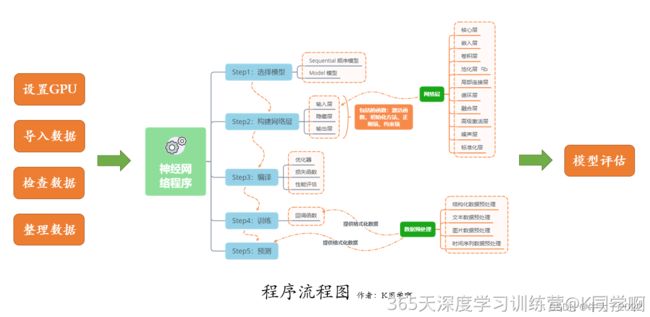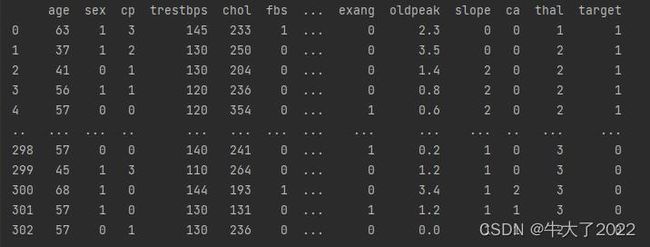深度学习Week5-心脏病预测(RNN)
本文为[365天深度学习训练营]中的学习记录博客
参考文章:[深度学习100例-循环神经网络(RNN)心脏病预测]
原作者:[K同学啊|接辅导、项目定制]
- 难度:新手入门⭐
要求:
- 本地读取并加载数据。(✔)
- 了解循环神经网络(RNN)的构建过程(✔)
- 测试集accuracy到达87%(✔)
拔高:
- 测试集accuracy到达89%(X)
环境:
- 语言环境:Python3.8
- 编译器:pycharm社区版
- 深度学习框架:TensorFlow2.4.1
- 数据地址:百度网盘
一、前期准备
1.设置GPU
import tensorflow as tf
gpus = tf.config.list_physical_devices("GPU")
if gpus:
gpu0 = gpus[0] # 如果有多个GPU,仅使用第0个GPU
tf.config.experimental.set_memory_growth(gpu0, True) # 设置GPU显存用量按需使用
tf.config.set_visible_devices([gpu0], "GPU")
print(gpus)这里遇到了bug,一是h5py版本出错了,卸了重装就行,二是缺少CUDNN64_8.DLL文件,这里推荐一个下载dll文件的网址,不收费可中文,非常好用。
cudnn64_8.dll 搜索结果 | DLL‑files.com
[PhysicalDevice(name='/physical_device:GPU:0', device_type='GPU')]
2. 导入数据
数据是csv表格,里面有各种参数,我们通过对数据的处理训练,实现预测功能
数据介绍:
age:1) 年龄
sex:2) 性别
cp:3) 胸痛类型 (4 values)
trestbps:4) 静息血压
chol:5) 血清胆甾醇 (mg/dl
fbs:6) 空腹血糖 > 120 mg/dl
restecg:7) 静息心电图结果 (值 0,1 ,2)
thalach:8) 达到的最大心率
exang:9) 运动诱发的心绞痛
oldpeak:10) 相对于静止状态,运动引起的ST段压低
slope:11) 运动峰值 ST 段的斜率
ca:12) 荧光透视着色的主要血管数量 (0-3)
thal:13) 0 = 正常;1 = 固定缺陷;2 = 可逆转的缺陷
target:14) 0 = 心脏病发作的几率较小 1 = 心脏病发作的几率更大
把数据文件放在和代码.py同一个目录下。
import pandas as pd
import numpy as np
df = pd.read_csv("heart.csv")
print(df)3.(次要)检查数据
由于数据可能有误输入为0的,可以检查一下有没有空值,大多情况下可以跳过这一步
print(df.isnull().sum())age 0
sex 0
cp 0
trestbps 0
chol 0
fbs 0
restecg 0
thalach 0
exang 0
oldpeak 0
slope 0
ca 0
thal 0
target 0
dtype: int64
每组数据空值个数都是0,数据正常。
二、数据预处理
1. 划分训练集与测试集
from sklearn.preprocessing import StandardScaler
from sklearn.model_selection import train_test_split
X = df.iloc[:,:-1] #iloc函数:对数据进行位置索引,从而在数据表中提取出相应的数据。
y = df.iloc[:,-1]
X_train, X_test, y_train, y_test = train_test_split(X, y, test_size = 0.1, random_state = 1)
print(X_train.shape, y_train.shape)(272, 13) (272,)
2. 标准化
# 将每一列特征标准化为标准正太分布,注意,标准化是针对每一列而言的
sc = StandardScaler()
X_train = sc.fit_transform(X_train)
X_test = sc.transform(X_test)
X_train = X_train.reshape(X_train.shape[0], X_train.shape[1], 1)
X_test = X_test.reshape(X_test.shape[0], X_test.shape[1], 1)三、构建RNN模型
函数原型
tf.keras.layers.SimpleRNN(units,activation='tanh',use_bias=True,kernel_initializer='glorot_uniform',
recurrent_initializer='orthogonal',bias_initializer='zeros',kernel_regularizer=None,recurrent_regularizer=None,bias_regularizer=None,activity_regularizer=None,kernel_constraint=None,recurrent_constraint=None,
bias_constraint=None,dropout=0.0,recurrent_dropout=0.0,return_sequences=False,return_state=False,
go_backwards=False,stateful=False,unroll=False,**kwargs)
关键参数说明:
units: 正整数,输出空间的维度。
activation: 要使用的激活函数。 默认:双曲正切(tanh)。 如果传入 None,则不使用激活函数 (即 线性激活:a(x) = x)。
use_bias: 布尔值,该层是否使用偏置向量。
kernel_initializer: kernel 权值矩阵的初始化器, 用于输入的线性转换 (详见 initializers)。
recurrent_initializer: recurrent_kernel 权值矩阵 的初始化器,用于循环层状态的线性转换 (详见 initializers)。
bias_initializer:偏置向量的初始化器 (详见initializers).
dropout: 在 0 和 1 之间的浮点数。 单元的丢弃比例,用于输入的线性转换。
import tensorflow
from tensorflow.keras.models import Sequential
from tensorflow.keras.layers import Dense,LSTM,SimpleRNN
model = Sequential()
model.add(SimpleRNN(200, input_shape= (13,1), activation='relu'))
model.add(Dense(100, activation='relu'))
model.add(Dense(1, activation='sigmoid'))
model.summary()四、编译模型
设置学习率啥的 和CNN一样(吧)
opt = tf.keras.optimizers.Adam(learning_rate=1e-4)
model.compile(loss='binary_crossentropy',
optimizer=opt,
metrics="accuracy")五、训练模型
因为都是数据,训练比图片数据快不少,100轮起步
epochs = 100
history = model.fit(X_train, y_train,
epochs=epochs,
batch_size=128,
validation_data=(X_test, y_test),
verbose=1)
六、模型评估
import matplotlib.pyplot as plt
acc = history.history['accuracy']
val_acc = history.history['val_accuracy']
loss = history.history['loss']
val_loss = history.history['val_loss']
epochs_range = range(epochs)
plt.figure(figsize=(14, 4))
plt.subplot(1, 2, 1)
plt.plot(epochs_range, acc, label='Training Accuracy')
plt.plot(epochs_range, val_acc, label='Validation Accuracy')
plt.legend(loc='lower right')
plt.title('Training and Validation Accuracy')
plt.subplot(1, 2, 2)
plt.plot(epochs_range, loss, label='Training Loss')
plt.plot(epochs_range, val_loss, label='Validation Loss')
plt.legend(loc='upper right')
plt.title('Training and Validation Loss')
plt.show()R1周的这个数据量有点少,这个抖动是正常的,可以通过扩充数据集来解决。
最后输出一下准确率(其实看第一百轮准确率即可):
scores = model.evaluate(X_test, y_test, verbose=0)
print("%s: %.2f%%" % (model.metrics_names[1], scores[1]*100))accuracy: 90.32%
这准确率太不稳定了,我训练了两次,一次84%,这次90%...
*拔高
结合week4猴痘识别的经验,先把训练的history中的batch_size降低到32
效果相当的不好,改回去准备从学习率入手
然而学习率无论是调大还是调小,准确率都稳定在87%左右,甚至调的幅度太大准确率会有明显下降...
可能是数据集太小的缘故,以后发现优化方法再和大家分享



